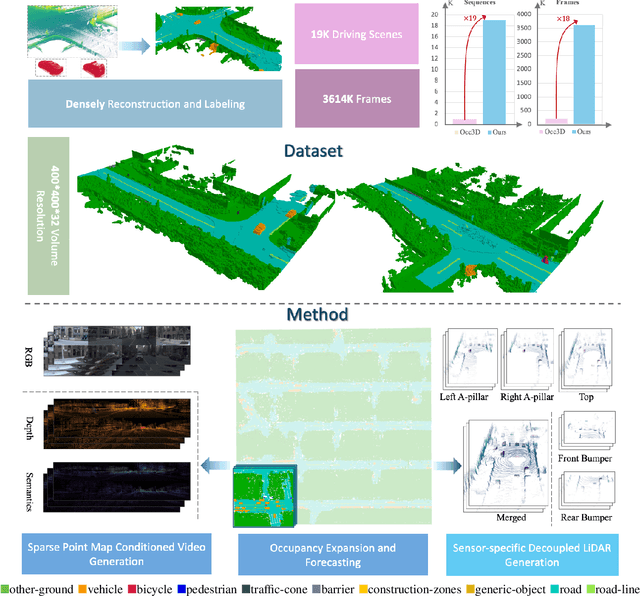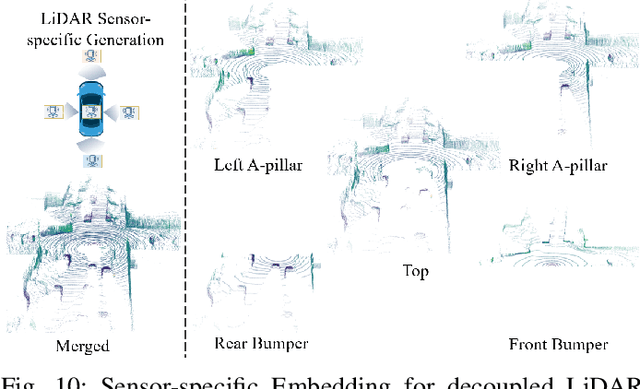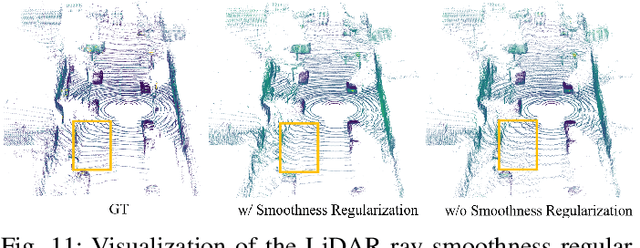Wenjun Zeng
Scaling Up Occupancy-centric Driving Scene Generation: Dataset and Method
Oct 27, 2025



Abstract:Driving scene generation is a critical domain for autonomous driving, enabling downstream applications, including perception and planning evaluation. Occupancy-centric methods have recently achieved state-of-the-art results by offering consistent conditioning across frames and modalities; however, their performance heavily depends on annotated occupancy data, which still remains scarce. To overcome this limitation, we curate Nuplan-Occ, the largest semantic occupancy dataset to date, constructed from the widely used Nuplan benchmark. Its scale and diversity facilitate not only large-scale generative modeling but also autonomous driving downstream applications. Based on this dataset, we develop a unified framework that jointly synthesizes high-quality semantic occupancy, multi-view videos, and LiDAR point clouds. Our approach incorporates a spatio-temporal disentangled architecture to support high-fidelity spatial expansion and temporal forecasting of 4D dynamic occupancy. To bridge modal gaps, we further propose two novel techniques: a Gaussian splatting-based sparse point map rendering strategy that enhances multi-view video generation, and a sensor-aware embedding strategy that explicitly models LiDAR sensor properties for realistic multi-LiDAR simulation. Extensive experiments demonstrate that our method achieves superior generation fidelity and scalability compared to existing approaches, and validates its practical value in downstream tasks. Repo: https://github.com/Arlo0o/UniScene-Unified-Occupancy-centric-Driving-Scene-Generation/tree/v2
Tools are under-documented: Simple Document Expansion Boosts Tool Retrieval
Oct 26, 2025Abstract:Large Language Models (LLMs) have recently demonstrated strong capabilities in tool use, yet progress in tool retrieval remains hindered by incomplete and heterogeneous tool documentation. To address this challenge, we introduce Tool-DE, a new benchmark and framework that systematically enriches tool documentation with structured fields to enable more effective tool retrieval, together with two dedicated models, Tool-Embed and Tool-Rank. We design a scalable document expansion pipeline that leverages both open- and closed-source LLMs to generate, validate, and refine enriched tool profiles at low cost, producing large-scale corpora with 50k instances for embedding-based retrievers and 200k for rerankers. On top of this data, we develop two models specifically tailored for tool retrieval: Tool-Embed, a dense retriever, and Tool-Rank, an LLM-based reranker. Extensive experiments on ToolRet and Tool-DE demonstrate that document expansion substantially improves retrieval performance, with Tool-Embed and Tool-Rank achieving new state-of-the-art results on both benchmarks. We further analyze the contribution of individual fields to retrieval effectiveness, as well as the broader impact of document expansion on both training and evaluation. Overall, our findings highlight both the promise and limitations of LLM-driven document expansion, positioning Tool-DE, along with the proposed Tool-Embed and Tool-Rank, as a foundation for future research in tool retrieval.
Vision-Centric Activation and Coordination for Multimodal Large Language Models
Oct 16, 2025Abstract:Multimodal large language models (MLLMs) integrate image features from visual encoders with LLMs, demonstrating advanced comprehension capabilities. However, mainstream MLLMs are solely supervised by the next-token prediction of textual tokens, neglecting critical vision-centric information essential for analytical abilities. To track this dilemma, we introduce VaCo, which optimizes MLLM representations through Vision-Centric activation and Coordination from multiple vision foundation models (VFMs). VaCo introduces visual discriminative alignment to integrate task-aware perceptual features extracted from VFMs, thereby unifying the optimization of both textual and visual outputs in MLLMs. Specifically, we incorporate the learnable Modular Task Queries (MTQs) and Visual Alignment Layers (VALs) into MLLMs, activating specific visual signals under the supervision of diverse VFMs. To coordinate representation conflicts across VFMs, the crafted Token Gateway Mask (TGM) restricts the information flow among multiple groups of MTQs. Extensive experiments demonstrate that VaCo significantly improves the performance of different MLLMs on various benchmarks, showcasing its superior capabilities in visual comprehension.
ANTS: Shaping the Adaptive Negative Textual Space by MLLM for OOD Detection
Sep 04, 2025Abstract:The introduction of negative labels (NLs) has proven effective in enhancing Out-of-Distribution (OOD) detection. However, existing methods often lack an understanding of OOD images, making it difficult to construct an accurate negative space. In addition, the presence of false negative labels significantly degrades their near-OOD performance. To address these issues, we propose shaping an Adaptive Negative Textual Space (ANTS) by leveraging the understanding and reasoning capabilities of multimodal large language models (MLLMs). Specifically, we identify images likely to be OOD samples as negative images and prompt the MLLM to describe these images, generating expressive negative sentences that precisely characterize the OOD distribution and enhance far-OOD detection. For the near-OOD setting, where OOD samples resemble the in-distribution (ID) subset, we first identify the subset of ID classes that are visually similar to negative images and then leverage the reasoning capability of MLLMs to generate visually similar negative labels tailored to this subset, effectively reducing false negatives and improving near-OOD detection. To balance these two types of negative textual spaces, we design an adaptive weighted score that enables the method to handle different OOD task settings (near-OOD and far-OOD) without relying on task-specific prior knowledge, making it highly adaptable in open environments. On the ImageNet benchmark, our ANTS significantly reduces the FPR95 by 4.2\%, establishing a new state-of-the-art. Furthermore, our method is training-free and zero-shot, enabling high scalability.
Perceiving and Acting in First-Person: A Dataset and Benchmark for Egocentric Human-Object-Human Interactions
Aug 06, 2025Abstract:Learning action models from real-world human-centric interaction datasets is important towards building general-purpose intelligent assistants with efficiency. However, most existing datasets only offer specialist interaction category and ignore that AI assistants perceive and act based on first-person acquisition. We urge that both the generalist interaction knowledge and egocentric modality are indispensable. In this paper, we embed the manual-assisted task into a vision-language-action framework, where the assistant provides services to the instructor following egocentric vision and commands. With our hybrid RGB-MoCap system, pairs of assistants and instructors engage with multiple objects and the scene following GPT-generated scripts. Under this setting, we accomplish InterVLA, the first large-scale human-object-human interaction dataset with 11.4 hours and 1.2M frames of multimodal data, spanning 2 egocentric and 5 exocentric videos, accurate human/object motions and verbal commands. Furthermore, we establish novel benchmarks on egocentric human motion estimation, interaction synthesis, and interaction prediction with comprehensive analysis. We believe that our InterVLA testbed and the benchmarks will foster future works on building AI agents in the physical world.
Plasticine: Accelerating Research in Plasticity-Motivated Deep Reinforcement Learning
Apr 24, 2025Abstract:Developing lifelong learning agents is crucial for artificial general intelligence. However, deep reinforcement learning (RL) systems often suffer from plasticity loss, where neural networks gradually lose their ability to adapt during training. Despite its significance, this field lacks unified benchmarks and evaluation protocols. We introduce Plasticine, the first open-source framework for benchmarking plasticity optimization in deep RL. Plasticine provides single-file implementations of over 13 mitigation methods, 10 evaluation metrics, and learning scenarios with increasing non-stationarity levels from standard to open-ended environments. This framework enables researchers to systematically quantify plasticity loss, evaluate mitigation strategies, and analyze plasticity dynamics across different contexts. Our documentation, examples, and source code are available at https://github.com/RLE-Foundation/Plasticine.
Interpretable Single-View 3D Gaussian Splatting using Unsupervised Hierarchical Disentangled Representation Learning
Apr 05, 2025Abstract:Gaussian Splatting (GS) has recently marked a significant advancement in 3D reconstruction, delivering both rapid rendering and high-quality results. However, existing 3DGS methods pose challenges in understanding underlying 3D semantics, which hinders model controllability and interpretability. To address it, we propose an interpretable single-view 3DGS framework, termed 3DisGS, to discover both coarse- and fine-grained 3D semantics via hierarchical disentangled representation learning (DRL). Specifically, the model employs a dual-branch architecture, consisting of a point cloud initialization branch and a triplane-Gaussian generation branch, to achieve coarse-grained disentanglement by separating 3D geometry and visual appearance features. Subsequently, fine-grained semantic representations within each modality are further discovered through DRL-based encoder-adapters. To our knowledge, this is the first work to achieve unsupervised interpretable 3DGS. Evaluations indicate that our model achieves 3D disentanglement while preserving high-quality and rapid reconstruction.
ShieldGemma 2: Robust and Tractable Image Content Moderation
Apr 01, 2025Abstract:We introduce ShieldGemma 2, a 4B parameter image content moderation model built on Gemma 3. This model provides robust safety risk predictions across the following key harm categories: Sexually Explicit, Violence \& Gore, and Dangerous Content for synthetic images (e.g. output of any image generation model) and natural images (e.g. any image input to a Vision-Language Model). We evaluated on both internal and external benchmarks to demonstrate state-of-the-art performance compared to LlavaGuard \citep{helff2024llavaguard}, GPT-4o mini \citep{hurst2024gpt}, and the base Gemma 3 model \citep{gemma_2025} based on our policies. Additionally, we present a novel adversarial data generation pipeline which enables a controlled, diverse, and robust image generation. ShieldGemma 2 provides an open image moderation tool to advance multimodal safety and responsible AI development.
MultiConIR: Towards multi-condition Information Retrieval
Mar 11, 2025



Abstract:In this paper, we introduce MultiConIR, the first benchmark designed to evaluate retrieval models in multi-condition scenarios. Unlike existing datasets that primarily focus on single-condition queries from search engines, MultiConIR captures real-world complexity by incorporating five diverse domains: books, movies, people, medical cases, and legal documents. We propose three tasks to systematically assess retrieval and reranking models on multi-condition robustness, monotonic relevance ranking, and query format sensitivity. Our findings reveal that existing retrieval and reranking models struggle with multi-condition retrieval, with rerankers suffering severe performance degradation as query complexity increases. We further investigate the performance gap between retrieval and reranking models, exploring potential reasons for these discrepancies, and analysis the impact of different pooling strategies on condition placement sensitivity. Finally, we highlight the strengths of GritLM and Nv-Embed, which demonstrate enhanced adaptability to multi-condition queries, offering insights for future retrieval models. The code and datasets are available at https://github.com/EIT-NLP/MultiConIR.
Disentangled World Models: Learning to Transfer Semantic Knowledge from Distracting Videos for Reinforcement Learning
Mar 11, 2025Abstract:Training visual reinforcement learning (RL) in practical scenarios presents a significant challenge, $\textit{i.e.,}$ RL agents suffer from low sample efficiency in environments with variations. While various approaches have attempted to alleviate this issue by disentanglement representation learning, these methods usually start learning from scratch without prior knowledge of the world. This paper, in contrast, tries to learn and understand underlying semantic variations from distracting videos via offline-to-online latent distillation and flexible disentanglement constraints. To enable effective cross-domain semantic knowledge transfer, we introduce an interpretable model-based RL framework, dubbed Disentangled World Models (DisWM). Specifically, we pretrain the action-free video prediction model offline with disentanglement regularization to extract semantic knowledge from distracting videos. The disentanglement capability of the pretrained model is then transferred to the world model through latent distillation. For finetuning in the online environment, we exploit the knowledge from the pretrained model and introduce a disentanglement constraint to the world model. During the adaptation phase, the incorporation of actions and rewards from online environment interactions enriches the diversity of the data, which in turn strengthens the disentangled representation learning. Experimental results validate the superiority of our approach on various benchmarks.
 Add to Chrome
Add to Chrome Add to Firefox
Add to Firefox Add to Edge
Add to Edge